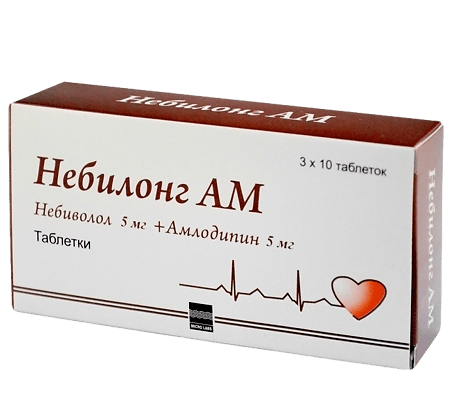No products in the cart.
Nebilong AM, tablets 5 mg+5 mg 30 pcs
€1.00
Out of stock
(E-mail when Stock is available)
Description
Pharmacodynamics
It selectively blocks beta1-adrenoreceptors, modulates endothelial relaxing factor (NO) synthesis. The decrease in BP is due to a decrease in cardiac output, RBC, RPS, inhibition of renin formation, partial loss of baroreceptor sensitivity. Hypotensive effect usually develops in 1-2 weeks and stabilizes within 4 weeks.
Lower HR at rest and during exercise, lower left ventricular BP, improve diastolic filling of heart, decrease myocardial oxygen demand (antianginal activity), decrease myocardial mass (by 9.7%) and myocardial mass index (by 5.1%). According to the data of daily monitoring it favorably influences daily BP rhythm in patients with both normal and abnormal rhythm. It has no negative effect on lipid metabolism.
Pharmacokinetics
When taken orally, it is rapidly absorbed. Bioavailability is 12% in persons with “fast” metabolism (the “first pass” effect through the liver) and is almost complete in patients with “slow” metabolism. Binds with plasma proteins by 98%.
The equilibrium concentration in patients with “fast” metabolism is reached within 24 hours, T1/2 is about 10 hours, in “slow” – 3-5 times more. It is converted by alicyclic and aromatic hydroxylation, partially N-dealkylated; the resulting hydroxy- and amino derivatives conjugate with glucuronic acid and are excreted as O- and N-glucuronides. The T1/2 of hydroxymetabolites for people with “fast” metabolism is on average 24 h, with “slow” metabolism twice as long. It is excreted by the kidneys (40%) and intestines (60%). It penetrates through the HEB, is secreted into breast milk.
Indications
Indications
Arterial hypertension (monotherapy or in combination with other hypotensive agents), CHD, angina pectoris.
Active ingredient
Active ingredient
Composition
Composition
Active ingredients:
amlodipine 5 mg;
nebivololol 5 mg.
How to take, the dosage
How to take, the dosage
Overly, at the same time of day, without chewing, with enough water, during or after meals – 5 mg once a day.
Patients with renal insufficiency or patients older than 65 years – 2.5 mg/day.
The maximum daily dose is 10 mg.
Interaction
Interaction
Calcium channel blockers increase AV conduction blockade, class I antiarrhythmics and amiodarone prolong the time of excitation through the atria.
The anesthetics (cyclopropane, diethyl ether, trichloroethylene), tricyclic antidepressants, barbiturates, phenothiazine derivatives potentiate hypotension, cimetidine and nicardipine increase plasma concentration, sympathomimetics negate activity.
Special Instructions
Special Instructions
The therapy should be discontinued gradually (over 1-2 weeks). Decrease of HR up to 55 beats/min requires dose reduction. Against the background of diabetes mellitus it is possible to mask the signs of hypoglycemia, against thyroid hyperfunction – tachycardia. May increase reactions to pollen and other allergens.
It should be withdrawn 24 h before surgical intervention using general anesthesia (including dental surgery) or choose an anesthetic agent with the least negative inotropic effect.
When concomitant administration of antacids is necessary, nebivololol is taken with meals, and antacids are taken between meals. Use with caution during work for drivers of vehicles and people whose profession involves high concentration.
It is recommended to avoid alcohol intake during treatment.
Contraindications
Contraindications
Hypersensitivity, sinus bradycardia (less than 45-50 bpm).
AV blockade of II-III degree, severe heart failure refractory to treatment;
Particularly severe heart failure, peripheral circulatory disorders, bronchial bronchitis.
Peripheral circulatory disorders, sinoatrial block, liver function abnormalities, bronchial asthma, bronchospasm, pregnancy, breast-feeding, pediatric age.
Side effects
Side effects
CNS and peripheral nervous system disorders: headache, dizziness, fatigue, paresthesias, depression, decreased ability to concentrate, drowsiness, insomnia, nightmares, hallucinations.
Digestive system disorders: nausea, constipation, diarrhea, dry mouth.
Cardiovascular system disorders: bradycardia, orthostatic hypotension, dyspnea, edema, heart failure, AV-blockade, heart rhythm disorders, Raynaud’s syndrome, cardialgia.
Allergic reactions: skin rash.
Others: bronchospasm (including in the absence of obstructive lung disease in the anamnesis), photodermatosis, hyperhidrosis, rhinitis.
Overdose
Overdose
Symptoms: bradycardia, arterial hypotension, bronchospasm, acute heart failure.
Treatment: gastric lavage, administration of activated charcoal, administration of laxatives; possible AV and administration of atropine (in bradycardia and increased vagotonia), plasma or plasma substitutes, if necessary – catecholamines.
. To stop the beta-adrenoblocking effect – isoprenaline hydrochloride (slowly, IV, in an initial dose of 5 mcg/min until the desired effect is achieved), dobutamine (in an initial dose – 2.5 mcg/min), in the absence of effect – glucagon (IV 50-100 mcg/kg, repeatedly after 1 hour – 70 mcg/kg/h infusion). In AV blockade – transvenous stimulation.
Pregnancy use
Pregnancy use
The use in pregnancy is possible only under strict indications (due to the possible development of bradycardia, arterial hypotension, hypoglycemia and respiratory paralysis in the newborn).
The use of nebivololol should be stopped 48-72 hours before delivery. Where this is not possible, close monitoring of the newborn should be ensured for 48-72 h after delivery.
Additional information
| Shelf life | 3 years |
|---|---|
| Conditions of storage | In a light-protected place, at a temperature not exceeding 25 °C |
| Manufacturer | Micro Labs Ltd, India |
| Medication form | pills |
| Brand | Micro Labs Ltd |
Related products
Buy Nebilong AM, tablets 5 mg+5 mg 30 pcs with delivery to USA, UK, Europe and over 120 other countries.












